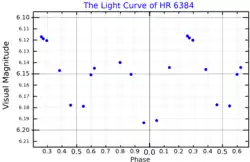| Observation data Epoch J2000 Equinox J2000 | |
|---|---|
| Constellation | Ara |
| Right ascension | 17h 14m 13.40536s[2] |
| Declination | –56° 53′ 18.6897″[2] |
| Apparent magnitude (V) | 6.153[1] |
| Characteristics | |
| Spectral type | M1/M2II/III + A[3] |
| U−B color index | +1.340[1] |
| B−V color index | +1.787[1] |
| Variable type | ellipsoidal variable[4] |
| Astrometry | |
| Radial velocity (Rv) | −34.0±4.0[5] km/s |
| Proper motion (μ) | RA: 2.760[2] mas/yr Dec.: –7.033[2] mas/yr |
| Parallax (π) | 2.2407 ± 0.1939 mas[2] |
| Distance | 1,500 ± 100 ly (450 ± 40 pc) |
| Absolute magnitude (MV) | −2.20[5] |
| Details | |
| Radius | 160.39+9.31 −23.02[2] R☉ |
| Luminosity | 3,732±368[2] L☉ |
| Temperature | 3,562+287 −99[2] K |
| Other designations | |
| Database references | |
| SIMBAD | data |
HR 6384 is a binary star system in the southern constellation of Ara, the Altar. The system is faintly visible to the naked eye with a combined apparent visual magnitude that fluctuates around 6.153,[1] and it is located at a distance of approximately 1,300 light-years (400 parsecs) from the Sun.[2] It is drifting closer with a radial velocity of around −34 km/s.[5]
The system appears to be a close, interacting binary with a hot secondary component of class A or hotter.[7] It forms a suspected ellipsoidal variable[4] with a period of 80 days and an amplitude variation of 0.08 in magnitude.[8] The primary component is an aging red giant/bright giant with a stellar classification of M1/M2II/III,[3] currently on the asymptotic giant branch.[9] With the supply of hydrogen at its core exhausted, it has expanded to 160 times the girth of the Sun. It is radiating 3,562 times the luminosity of the Sun from its enlarged photosphere at an effective temperature of 3,562 K.[2]
References
- 1 2 3 4 5 Walker, W. S. G.; Marino, B. F.; Herdman, G. (August 1985), "Photometry of HR 6384 - an 80 Day Ellipsoidal Binary?", Information Bulletin on Variable Stars, 2775: 1, Bibcode:1985IBVS.2775....1W.
- 1 2 3 4 5 6 7 8 9 10 Brown, A. G. A.; et al. (Gaia collaboration) (August 2018). "Gaia Data Release 2: Summary of the contents and survey properties". Astronomy & Astrophysics. 616. A1. arXiv:1804.09365. Bibcode:2018A&A...616A...1G. doi:10.1051/0004-6361/201833051. Gaia DR2 record for this source at VizieR.
- 1 2 Houk, Nancy (1979), Michigan catalogue of two-dimensional spectral types for the HD stars, vol. 1, Ann Arbor, Michigan: Dept. of Astronomy, University of Michigan, Bibcode:1978mcts.book.....H.
- 1 2 Samus, N. N.; et al. (2017), "General Catalogue of Variable Stars", Astronomy Reports, 5.1, 61 (1): 80–88, Bibcode:2017ARep...61...80S, doi:10.1134/S1063772917010085, S2CID 125853869.
- 1 2 3 Anderson, E.; Francis, Ch. (2012), "XHIP: An extended hipparcos compilation", Astronomy Letters, 38 (5): 331, arXiv:1108.4971, Bibcode:2012AstL...38..331A, doi:10.1134/S1063773712050015, S2CID 119257644.
- ↑ "V829 Ara". SIMBAD. Centre de données astronomiques de Strasbourg. Retrieved 2019-12-07.
- ↑ Ake, T. B.; Parsons, S. B. (March 1985), "HR 6384: a Probable Interacting Binary", Information Bulletin on Variable Stars, 2686: 1, Bibcode:1985IBVS.2686....1A.
- ↑ Hoffleit, Dorrit (1996), "A Catalogue of Correlations Between Eclipsing Binaries and Other Categories of Double Stars", The Journal of the American Association of Variable Star Observers, 24 (2): 105–116, Bibcode:1996JAVSO..24..105H.
- ↑ Eggen, Olin J. (July 1992), "Asymptotic giant branch stars near the sun", Astronomical Journal, 104 (1): 275–313, Bibcode:1992AJ....104..275E, doi:10.1086/116239.
